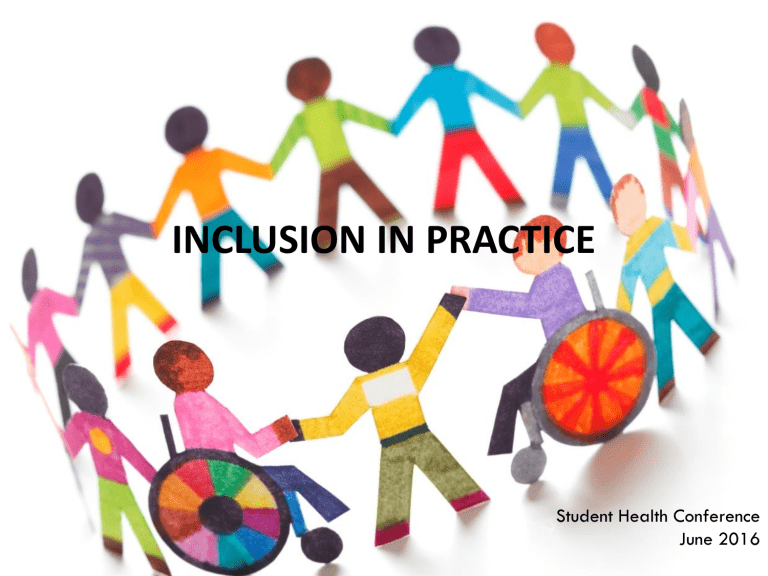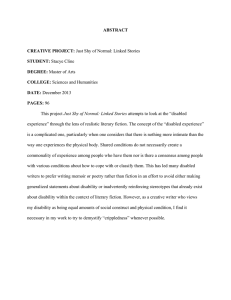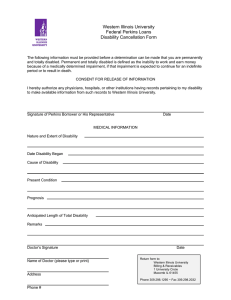Inclusion in Practice: Disability & International Students
advertisement

INCLUSION IN PRACTICE Student Health Conference June 2016 Armineh Soorenian PhD, University of Leeds Centre for Disability Studies, November 2011 I am an independent researcher based in Leeds. In November 2013 my book ‘Disabled International Students in British Higher Education: Experiences and Expectations’ was published by Sense Publishing House. Selected bibliography: Disability, Human Rights and the Limits of Humanitarianism (2014) Disabled International Students in British Higher Education Experiences and Expectations (2013) My research interests are: •Inclusive education •Disabled women •Disability hate crime •Disability arts and representations •Disability and the age of austerity I continue with researching, publishing, campaigning, lecturing and delivering workshops specifically on inclusive education issues. Disability Studies; emerging insights and perspectives (2008) arminehsoorenian1@gmail.com 0113 2176540 http://leeds.academia.edu/ArminehSoorenian https://www.linkedin.com/pub/armineh-soorenian/49/558/6a0 IMPETUS FOR MY ACADEMIC WORK ON INCLUSIVE EDUCATION • My personal and academic experience of encountering various physical, attitudinal, educational, funding and social barriers during my university journey in the UK • Shortage of national policy and literature relating to disabled international students’ specific concerns in the British educational context • Wanting to improve policy and practice for future disabled international students studying overseas, and by doing so contribute towards making universities inclusive on an international level. Two main models of disability The Individual Medical Model of Disability • IMPAIRMENT: … is any loss or abnormality of psychological, physiological, or anatomical structure or function. • DISABILITY: … is any restriction or lack (resulting from an impairment) of ability to perform an activity in the manner or within the range considered normal for a human being. • HANDICAP: … is a disadvantage for a given individual, resulting from an impairment or a disability that limits or prevents the fulfilment of a role that is normal … for that individual (Wood, 1980: 27-29). The Social Definition of Disability • … the disadvantage or restriction of activity caused by a contemporary social organisation which takes no or little account of people who have physical impairments and thus excludes them from participation in the mainstream of social activities. (UPIAS, 1976: 3-4). Group Exercise Group 1 - possible difficulties that disabled students may face Group 2 - potential barriers experienced by international students Barriers confronted by disabled students in their educational life INFORMATION Inaccessible - not in alternative formats or easy to find; Untimely or delayed; Irrelevant or non-specific disability related information; Insensitive to diversity of needs ACCESS Natural hilly landscape of their university city; Cobblestones and uneven pavements; Long distances between university departments; Heavy and narrow doors to buildings; Old listed buildings without lifts or ramps; Inaccessible furniture (inappropriate height & layout); Inadequate spaces for wheelchair-users; Inadequate lighting; Visual signage – not Braille; Touch screens FUNDING Having an impairment often leads to additional expenditure; Recent cuts to Disabled Students Allowance Difficulties experienced by international students in their universities Practical challenges: time-management, visas, provision of information pre-/post-arrival, accommodation, funding and policies relating to financial support; Emotional and affective issues: stress, homesickness, lack of confidence, participation in support services; Cultural adaptation and integration: developing adequate cross-cultural skills, English language acquisition/competence; Pedagogic difficulties: unfamiliarity with the UK system and academic conventions, seminar, study and writing skills, teaching/learning experiences, linguistic diversity; Curriculum and assessment: appropriate course delivery design, performance and outcomes. Group Discussion The overlapping issues of disabled international students. Disabled international students’ specific concerns Unable to obtain information about university life from outside the UK due to location and impairment related difficulties; Ineligibility for Disabled Students’ Allowance or any other state benefit Cultural interpretation and variation in the understanding and treatment of ‘disability’ Inadequacy and complexity of disability categories in English for some international students Not knowing how to disclose their impairments in a different cultural and linguistic context Fear of encountering stereotypical reactions following disclosure Absence of relevant information received on disability support Negative attitudes of staff - an unfamiliarity and unwillingness to help disabled international students with their intersectional difficulties Group Discussion Ways that inclusive practices can be applied to the barriers discussed Practical Steps Towards Inclusion • Change of attitude • Training in disability and cultural awareness • Commitment to universal design for physical access • Collaboration with student representatives in relation to disabled and international students’ issues • Commitment to remove disabling and cultural barriers • Listening to a range of students’ voices and lived experiences • Promotion of creative and flexible approaches Conclusion If the university facilities and processes are designed in ways that the majority of students are accommodated most of the time, automatically an inclusive environment for ‘all’ is created and nurtured, regardless of students’ circumstances, social origin or ethnic group. References Please see the speaker notes for reference information.





